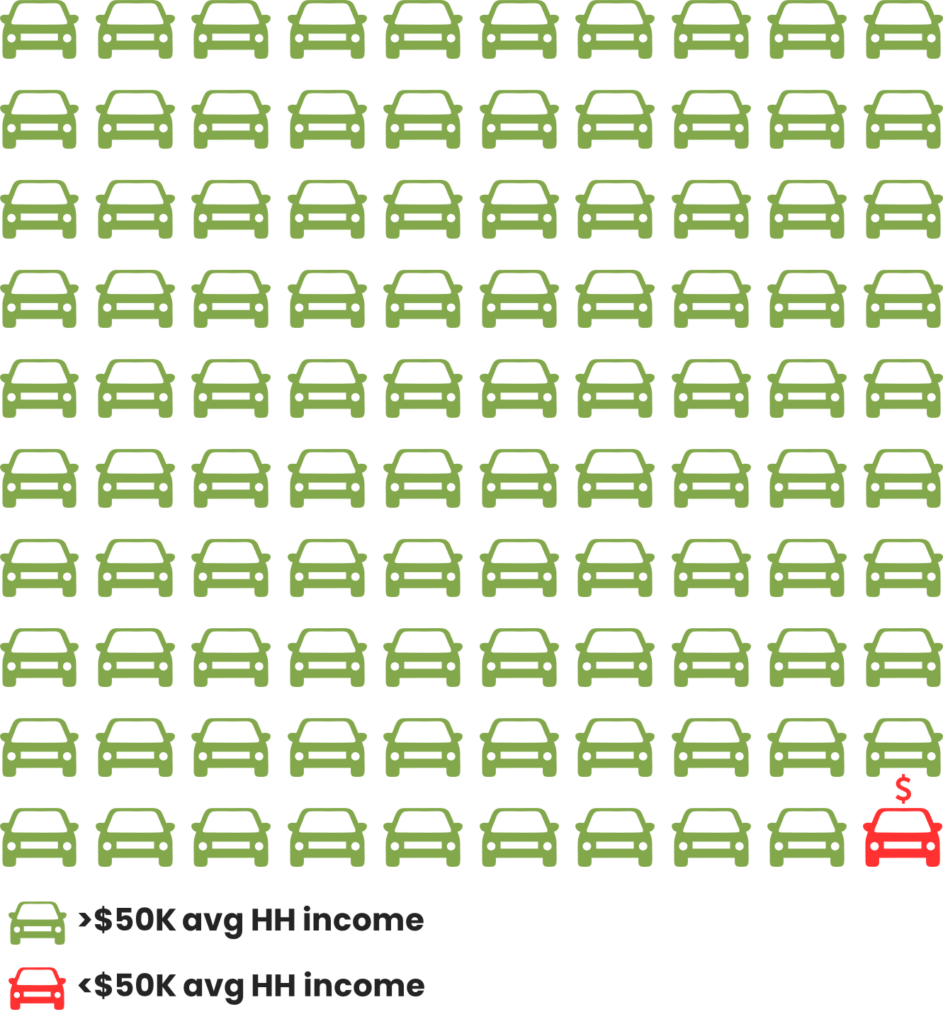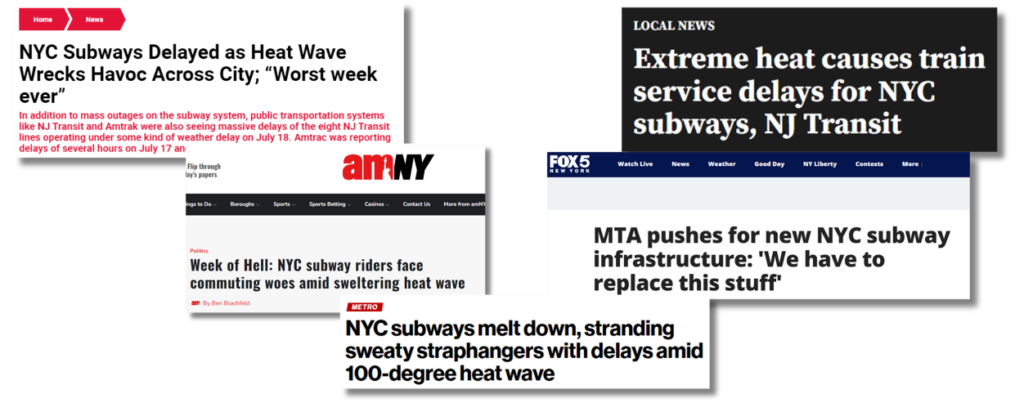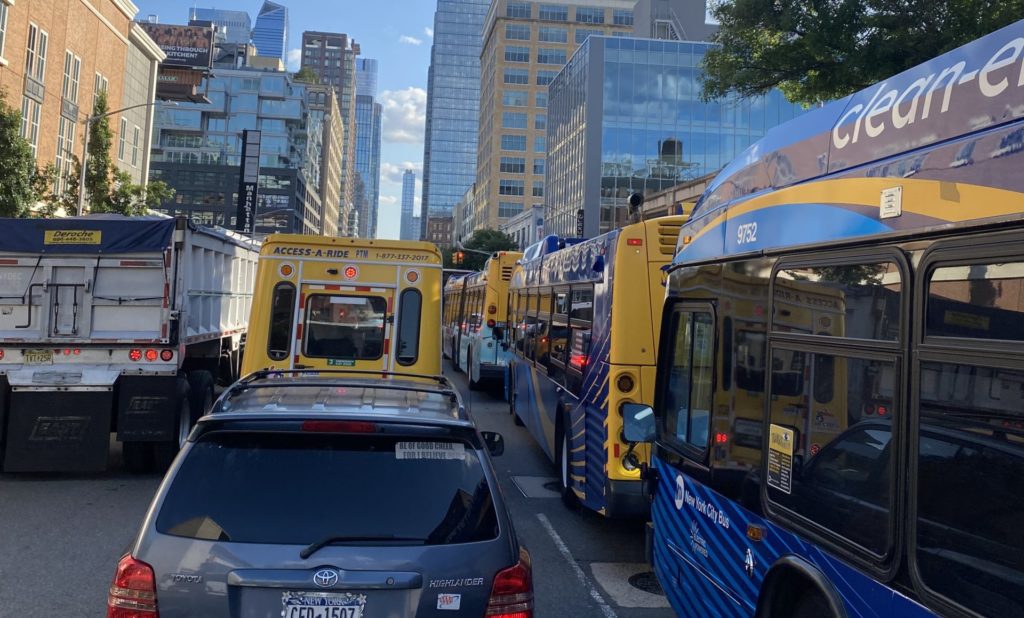15 Facts: One for Each Billion Lost Without Congestion Pricing:
A joint report from the Permanent Citizens Advisory Committee to the MTA & the New York Building Congress that dismisses dubious talking points with data-driven facts.
(July 30, 2024) Today marks not only 30 days since congestion pricing was set to go into effect, but also an estimated $82,000,000 in lost toll revenue for crucial MTA capital improvements that would improve the accessibility and equity of our mass transit system.
At the MTA’s June board meeting, one that was supposed to mark the start of this revolutionary program years in the making, we got a glimpse into the disastrous consequences of the delay. Immediately, the MTA announced the cancellation of long-awaited programs like the Second Avenue subway extension to East Harlem; ADA accessibility upgrades at 25 subway stations across the five boroughs and the Long Island Rail Road; critical resiliency projects for Metro-North; and fleet, track, and signal updates to ensure reliable service and avoid another “Summer of Hell.”
All of these losses are already negatively affecting the millions of New Yorkers dependent on our public transit system. Conditions will surely continue to deteriorate as the MTA struggles to fill holes for “state-of-good-repair” fixes, and sustainable funding for capital projects.
Compounding this, with the November election fast approaching, there is an added threat of New York losing any chance of federal funding should the rabidly anti-environment Donald Trump win the presidency. We cannot leave an agency responsible for transporting over 1.3 billion passengers a year in this state to the whims of a man who has already called congestion pricing “a disaster.”
That means action must be taken this year to enact congestion pricing and ensure federal funding continues as planned regardless of who resides in the White House.
Together, as independent organizations concerned about the fiscal and functional future of New York, and which both inherently work alongside the MTA, we urge the Governor, the Legislature, the MTA Board, and everyday New Yorkers to review the facts we have compiled below. We call for the Governor to commit to reinstating congestion pricing as soon as possible, but at a minimum by December 1 to avoid political shifts in Washington and allow time for implementation before a possible change in administration.
It is clear that New York City cannot wait another full year without congestion pricing, and the excuses parading as facts we have heard since the decision to delay the program are inadequate; we as New Yorkers deserve the truth. Here, we do our best to provide facts to cut through the noise you may be hearing from disingenuous naysayers:
- MYTH: Congestion pricing will hurt low-income New Yorkers.
FACT: Of the 1.5 million people who work in the Central Business District, 1.3 million – 86% – take public transit1.
Only 1% of those who drive into the Central Business District have incomes under $50,000, and those drivers would get a partial exemption from the toll2.

On average, people who commute to Manhattan by car have 25% higher incomes than transit riders. A report from the Tri-State Transportation Campaign found that while the median income across New York City is $55,752, the median income of a household with a vehicle is $85,000 compared to the $40,630 median income for households without a vehicle3.
The disparities in these economic indicators clearly demonstrate that New Yorkers with incomes below the median are not at all as reliant on cars as critics of congestion pricing claim.
That means hundreds of thousands more essential workers in healthcare, education, construction, and other fields depend on transit to get to work than drive a car.
Not only will the pause of congestion pricing hurt existing commuters and residents, but, according to the Federal Highway Administration (FHWA), every “$1 billion in Federal highway and transit investment funded by the American Jobs Act would support 13,000 jobs for one year.” If applied to the $16.5 billion deferred by the loss of congestion pricing, this translates to 214,500 high-paying job opportunities lost4.
- MYTH: “The state is committed to funding the transit investments in the 2020-2024 MTA Capital Plan.”
FACT: It’s been two months since the pause was announced, and as PCAC analysis found no other viable proposals have yet been offered5. Of the funding mechanisms proposed as alternatives to congestion pricing, many are regressive, others vastly inadequate to fill the gap, and some both. None of them meet the three core goals of congestion pricing: reducing traffic; improving air quality – while providing funding for mitigation in Environmental Justice communities; and raising critical funding for transit improvements.
The State Legislature recognized this when they rightfully rejected two proposals that would have impacted millions more New Yorkers than congestion pricing and offered zero environmental benefit: a hike on the payroll mobility tax solely for NYC residents, and a billion-dollar “I.O.U.”
The legislature is now out of session until 2025, when they will be tasked with funding the MTA’s 2025-2029 capital plan; they have no plans to return for a special session. The Governor has indicated tackling congestion pricing as part of next year’s budget talks, but we’ve already detailed the risks that a potential Trump administration could bring by then. It’s too late. Action is needed now.
Luckily, as required by law, there is a plan to fund the transit investments in the 2020-2024 MTA Capital Plan: congestion pricing! The Governor simply needs to request the tolling agreement from the federal government to begin the program and flip the switch.
- MYTH: Congestion pricing only helps Manhattanites, while harming residents of the outer boroughs and the suburbs.
FACT: Quite the opposite – the delay of congestion pricing will negatively affect opportunities for workers from across the state – from the steelworkers who manufacture materials upstate, to the truck drivers that transport beams, to the pile drivers mining tunnels, to the laborers constructing slurry, and everything and everyone in between.
The fact is, every single part of the state will lose jobs because of this6.

Because jobs created throughout the development process are covered by federal Davis-Bacon prevailing wage regulations, they predominantly go to union construction workers, the majority of whom live outside of, but work in, Manhattan.
In February, the MTA estimated that the capital projects reliant on congestion pricing revenue would create 57,000 prevailing wage jobs, not to mention the tens of thousands of jobs for future projects7. For reference, in 2009 then-Congresswoman Carolyn Maloney found that in the first two years of construction on the Second Avenue Subway, 16,000 jobs were created, generating $842 million in wages and $2.87 billion in economic activity8.
The loss of these good paying opportunities not only affect existing union members, but also limits the number of new apprenticeship slots.
Furthermore, the lack of capital funding will harm opportunities for M/WBE and veteran-owned businesses – to which the MTA paid $833 million across 500 different firms in 2023 alone. The economic consequences of the delay are not unique to Manhattan and will negatively affect all New Yorkers.
- MYTH: The MTA’s finances don’t impact my local economy, especially if I live outside of the service area.
FACT: The MTA’s capital plan supports New York jobs in every Congressional and state Senate district, and 148/150 Assembly districts, by paying New York State companies more than $30 billion for goods and services in support of MTA capital plans since 20149.
Similarly, people from across the NY-NJ-CT-PA region rely on the economic engine that is New York City – and the transit system that powers that engine – whether for work, education, health care, recreation, tourism, or family matters. Subways and buses, the LIRR, and Metro-North have allowed the region to grow and its commute shed to expand, increasing access to more affordable housing and communities in which to grow businesses or families.

- MYTH: LIRR and Metro-North riders won’t benefit from congestion pricing; only people in New York City will.
FACT: By law, the LIRR and Metro-North were to receive $1.5 billion in congestion pricing revenue per railroad. That constitutes 26% of the current LIRR capital plan’s funding and 32% of Metro-North’s. The pause will cancel and delay projects and in fact already has, with stop work orders issued for accessibility projects at LIRR’s Hollis and Forest Hills stations being the tip of the iceberg10.
- MYTH: Congestion pricing in NYC is just too unpopular to implement.
FACT: In cities that have launched similar programs, public opinion of congestion pricing was lowest just prior to implementation. This is normal and not surprising for any new municipal cost. However, support consistently increases once the public experiences the benefits: cleaner air, better transit, and safer streets.

Sources: TfL11, Tools of Change12, Siena College13, TMRB14
- MYTH: $15 is too much to pay for drivers, especially as the program rolls out.
FACT: An off-peak, round-trip Long Island Rail Road (LIRR) ticket between Penn Station and Valley Stream, just outside the city’s borders, costs $19.50. A family of four going to and from Manhattan by subway or bus costs $23.20.
We should be looking at ways to increase incentives for transit riders with additional discounts and fare reductions, so that instead of penalizing someone for doing the right thing for our roads and our environment, we aren’t incentivizing people onto the roads and off of mass transit even with a one-time, $15 daily toll.
That toll was also arrived at after months of study, community input, and debate. There is a false equivalence being cited to the fact that “London only charged £5” when they rolled out their plan. That sounds alarming at first – quite a big difference from $15 – but when accounting for inflation, that £5 in 2003 (exchange rate in Feb. 2003 of 1.59 = $7.95) is actually $13.57 today (cumulative rate of inflation 70.7%15) – not so very far off the $15.
- MYTH: The congestion pricing “pause” won’t affect contract awards.
FACT: It already has. As covered by Engineering News-Record16 on June 20, “Queens-based contractor C.A.C. was working on a $182 million utility relocation contract it won in January when the stop work order came across.”
You can’t award contracts without revenue. The pause completely stalled progress on the Second Avenue Subway, the order of 250+ electric buses, and more than 25 accessibility projects on the subway and LIRR.
- MYTH: Congestion pricing is just a cash grab for the MTA.
FACT: Congestion pricing has legally-required and extensively studied benefits beyond “just” funding the MTA: reducing traffic and congestion that costs the economy billions of dollars annually, improving air quality, making streets safer, and creating an all-around better region.
- MYTH: The MTA is a money pit.
FACT: Past results do not indicate future performance. Sure, the MTA has seen previous periods of mismanagement, but the agency is under new management and has changed its approach to doing business. It had a robust capital plan mandate and was carefully proceeding with it.
Transit is also the backbone of New York’s economy. Every dollar spent on transit yields four dollars in economic benefits17.

- MYTH: The MTA does not need the revenue from congestion pricing, since the $36 billion in funding is still the most the capital budget has ever received, and not all the money has been spent.
FACT: Every dollar of the $51 billion 2020-24 Capital Plan has been allocated to specific projects, so without the $15 billion congestion pricing was set to bring in, riders and contractors can expect a dramatic decrease in the amount of money available for capital investment.
At the June 2024 Board Meeting, the MTA confirmed that due to the loss of congestion pricing revenue, the Second Avenue Subway will be deferred, and previously allocated funds will have to go to state-of-good-repair. Additionally, 23 subway and two LIRR stations set to undergo accessibility renovations will be deferred, among many other lost projects18.
- MYTH: Congestion pricing won’t affect the MTA’s operating budget.
FACT: If the MTA has to issue debt earlier than anticipated – as it would to cover the cost of state-of-good-repair projects that still need to be completed in the 2020-2024 capital program – it would need to pay down the debt service from the operating budget. The effect on the operating funding, which pays for the labor, fuel, and other resources needed to maintain the service riders count on, could lead to service cuts, layoffs, and more drastic fare increases. It already led to decreases in bus service, now itself on pause thanks to a court order19.
- MYTH: The MTA can substitute congestion pricing revenue by addressing fare evasion.
FACT: Curbing fare evasion is critical for many reasons, but the revenue lost at the farebox would support the MTA’s operating budget.
Conversely, revenue from congestion pricing will be put in a dedicated lockbox to support the capital plan – and unlike a fare evasion crackdown, it can be bonded by a factor of fifteen. Fare evasion enforcement is also very costly in and of itself20.
- MYTH: Pausing congestion pricing won’t impact federal funding for the MTA.
FACT: Pausing congestion pricing puts $9.9 billion in Federal Transportation Administration funds for 95 approved MTA projects at risk. The MTA confirmed that of the $5 billion in state and federal funding allocated for Phase 2 of the Second Avenue Subway, the $3 billion in local funding will be transferred to cover state-of-good-repair, which makes $2 billion in federal funding and an additional $2 billion in federal support laid out in the 2020-2024 Capital Plan unavailable.
- MYTH: The MTA will be fine in the long run – it’s gotten by without this funding before and will again.
FACT: This isn’t like any situation before – everyone will feel the impact of this action, which will invariably result in slower, and less frequent and reliable service in the near term. Just this month, equipment failed on the A, B, D, F, and M lines, all of which were slated for decades-overdue upgrades with funds from congestion pricing21, stranding and delaying thousands of customers on a 100+-degree day. Incidents like these will increase without the funding needed to bring our system into the 21st century.

Almost a third of the funding for the MTA’s capital program is gone – and with it, projections for increased ridership, decreased traffic, and better air quality. The entire region loses.
Finally, while the postponement of Phase 2 of the Second Avenue Subway was a dramatic development – another broken promise for a community that has been waiting since the 1950’s for a replacement for the elevated, the long term effects on future infrastructure projects will continue to compound.
Without any definitive source of funding for the three Second Avenue Subway stations in Phase 2, we are putting an additional 10 stations on the East Side at risk for future generations of New Yorkers. Original plans for the Second Avenue Subway outlined in the Federal Environmental Impact Statement included two additional stages to follow the 125th extension – not including the possibility of a westward expansion to Broadway. In Phase 3, tunnels would be constructed from 62nd Street to 4th Street, opening new stations at 55th Street, 42nd Street, 34th Street, 23rd Street, 14th Street, and Houston Street, and Phase 4 would create additional stations at Grand Street, Chatham Square, Seaport, and Hanover Square.
Conclusion
Generational change is hard, costly, and often unpopular initially – yet almost always necessary. We cannot walk away from the responsibility of enabling it. We cannot give up on this once-in-a-lifetime opportunity to modernize and expand our transit system, make our roads safer, and make our air more breathable. Our organizations are ready to work with elected officials and provide our institutional knowledge to help find a path forward towards a better, more accessible, more equitable New York.
Sources
1 https://new.mta.info/document/127761
2 https://new.mta.info/document/127761
3 https://blog.tstc.org/wp-content/uploads/2017/04/how-car-free-is-nyc.pdf
4 https://www.fhwa.dot.gov/policy/otps/pubs/impacts/
5 https://pcac.org/report/fundingthecapitalplan/
6 https://reinventalbany.org/the-mta-is-big-business-in-the-tri-state-region/
7 https://new.mta.info/press-release/mta-details-accessibility-expansion-and-reliability-projects-risk-duecongestion
8 https://pcac.org/maloney-urges-second-avenue-subway-be-a-federal-infrastructure-priority/
9 https://reinventalbany.org/the-mta-is-big-business-in-the-tri-state-region/
10 https://new.mta.info/document/144141
11 https://content.tfl.gov.uk/impacts-monitoring-report-2.pdf
12 https://toolsofchange.com/userfiles/Stockholm%20Congestion%20Pricing%20-%20FINAL%202014.pdf
13 https://scri.siena.edu/wp-content/uploads/2024/04/SNY-April-2024-Poll-Release-FINAL.pdf
14 https://new.mta.info/document/127761
15 https://www.usinflationcalculator.com/
16 https://www.enr.com/articles/58849-mta-halts-second-ave-subway-construction-following-congestionpricing-
pause
17 https://www.apta.com/research-technical-resources/research-reports/economic-impact-of-publictransportation-
investment
18 https://new.mta.info/document/144141
19 https://nyc.us14.listmanage.
com/track/click?u=fac425258b04af614b47a3b18&id=4604c2c82b&e=a572d35ec9&utm_source=
bkreader&utm_campaign=bkreader%3A%20outbound&utm_medium=referral
20 https://hellgatenyc.com/the-nypd-spent-150-million-to-catch-farebeaters-who-cost-the-mta-104000/
